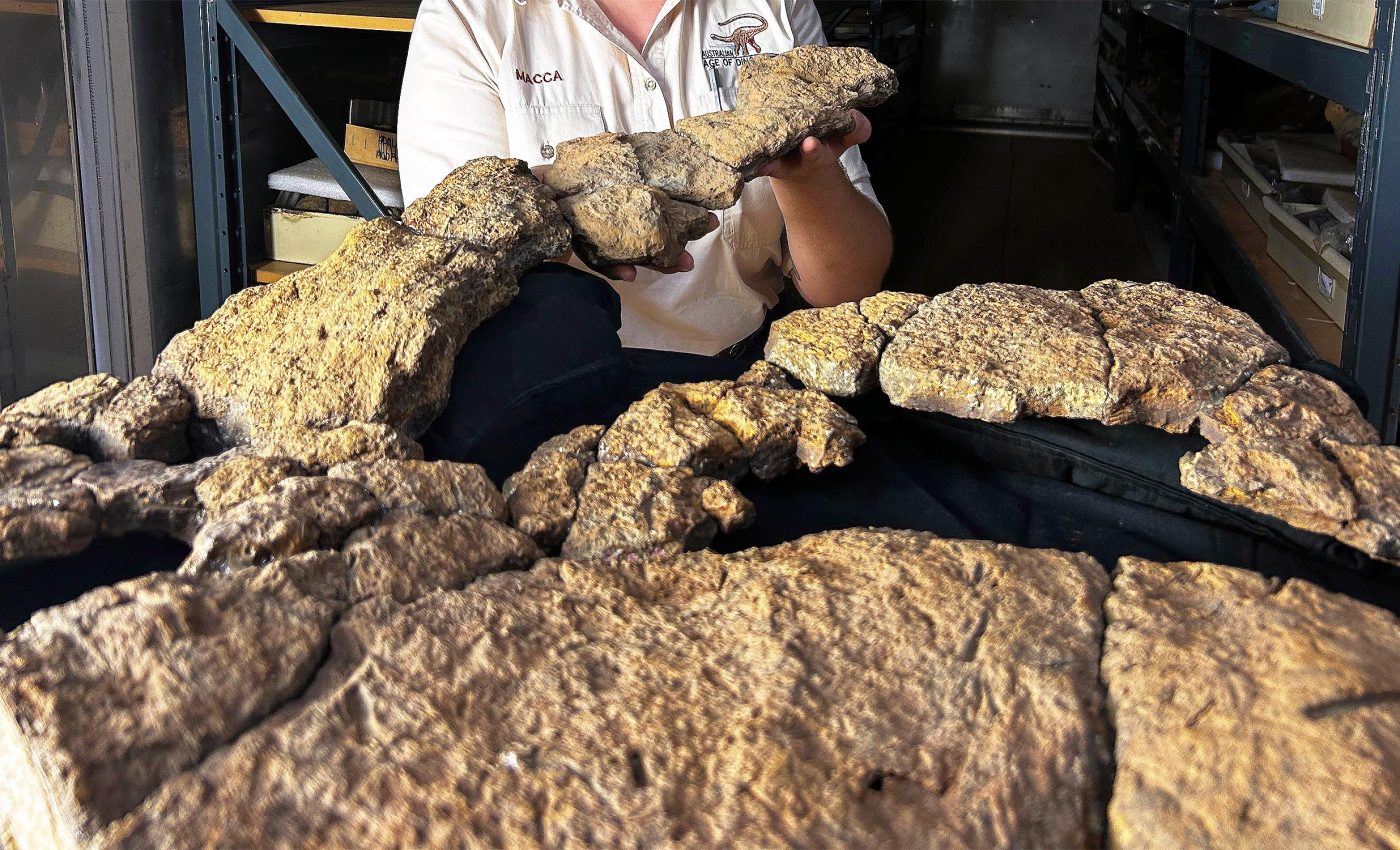
Fossilized guts reveal the eating habits of sauropod dinosaurs
Fossilized plant fragments preserved inside the belly of an Australian sauropod dinosaur have given researchers the first complete snapshot of what these long-necked giants actually ate. The evidence firmly backs the long-held view that they were voracious herbivores.
The findings are based on a subadult specimen of Diamantinasaurus matildae that roamed what is now Queensland between 94 and 101 million years ago. Its last meals reveal a mixed, unchewed salad of conifer foliage, seed-fern fruiting bodies, and flowering-plant leaves.
The dinosaur broke off these plant fragments instead of chewing them, leaving the gut microbes to do the hard work of digestion.
Unique dinosaur discovery
“No genuine sauropod gut contents had ever been found anywhere before, despite sauropods being known from fossils found on every continent” said lead author Stephen Poropat, a paleontologist at Curtin University.
Until now, scientists pieced together sauropod menus indirectly – examining tooth scratches, jaw mechanics, and neck reach.
The new discovery provides something more definitive: a preserved cololite, or fossil gut content. Scientists can analyze this down to the species of plant it contains.
Big discovery in Australia
The breakthrough came during the 2017 field season at the Australian Age of Dinosaurs Museum. Volunteers preparing the Diamantinasaurus skeleton noticed a fractured, oddly packed slab of sediment lodged among the ribs.
Careful extraction revealed dozens of delicate plant fossils: scales from conifer needles, seed-fern pods. The researchers also found tender angiosperm leaves and even tiny shoots and bracts.

Chemical analyses later detected biomarkers of both angiosperms and gymnosperms, confirming the findings.
New insights into sauropod feeding
Microscopic inspection revealed that the sauropod had snapped, not shredded, most plant fragments.
“The plants within show evidence of having been severed, possibly bitten, but have not been chewed, supporting the hypothesis of bulk feeding in sauropods,” noted Poropat.
The conclusion matches anatomical expectations: sauropod teeth evolved for nipping vegetation rather than grinding it.
Instead, these dinosaurs likely swallowed mouthfuls whole, letting fermentation chambers and resident microbes break down the cellulose.
Chemical signatures in the cololite point to an “eat what’s within reach” strategy rather than selective browsing.
“This implies that at least some sauropods were not selective feeders, instead eating whatever plants they could reach and safely process,” Poropat explained.
That indiscriminate appetite would have amplified the ecological influence of sauropods. It allowed their vast bodies to recycle nutrients across entire landscapes during the Jurassic and Cretaceous.
A surprise serving of flowers
The team expected to find conifer and seed-fern remains, but the presence of flowering-plant foliage caught them off-guard.
“Angiosperms became approximately as diverse as conifers in Australia around 100 to 95 million years ago, when this sauropod was alive,” Poropat said.
“This suggests that sauropods had successfully adapted to eat flowering plants within 40 million years of the first evidence of the presence of these plants in the fossil record.”
The finding suggests these dinosaurs quickly incorporated new plant types as they emerged in Mesozoic ecosystems.
Because the specimen was a subadult, the researchers infer it could graze both low and mid-story vegetation. Hatchlings grazed only on groundcover, while fully-grown adults could strip branches from treetops.
The abundance of soft shoots and seed pods suggests that younger Diamantinasaurus individuals targeted nutrient-rich new growth, which ferments more easily than woody tissue.
One stomach, many questions
Poropat stresses that the study offers “a single data point.” The snapshot captures only the last few meals of one individual and may not represent typical diets, seasonal shifts, or adult feeding habits.
Even a single case shows that gut-content fossils, though rare, can confirm hypotheses and refine our view of dinosaur ecology.

The team hopes further excavations in the Winton Formation and other Cretaceous sites will yield additional cololites to broaden the picture.
Feeding for giants
Taken together, the findings bolster the idea that “indiscriminate bulk feeding” underpinned sauropod dominance for roughly 130 million years.
By gulping vast quantities of whatever greenery was available and outsourcing digestion to microbial partners, these giants could fuel bodies the size of whales on land.
As Poropat and colleagues point out, understanding that strategy not only illuminates dinosaur biology but also helps reconstruct the plant communities and nutrient cycles of ancient Earth.
The study is published in the journal Current Biology.
—–
Like what you read? Subscribe to our newsletter for engaging articles, exclusive content, and the latest updates.
Check us out on EarthSnap, a free app brought to you by Eric Ralls and Earth.com.
—–













